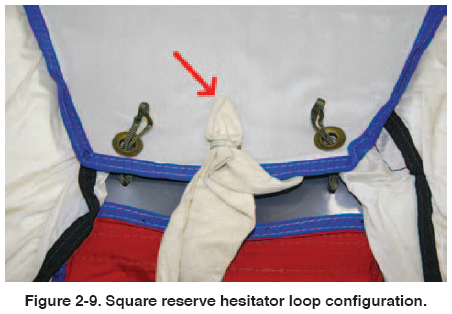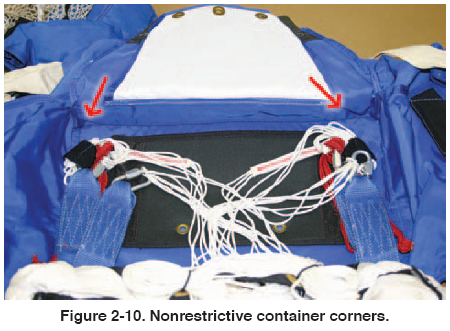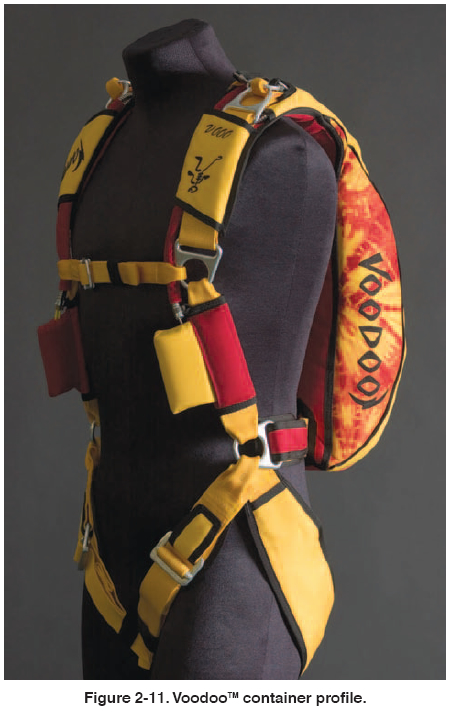Chapter 2
MODERN DESIGN CONCEPTS
The containers of today do more than simply enclose
the canopy and deployment device. Sport containers in
particular need to be designed so that they contribute to
the deployment needs of the specific parachute.
Piggyback designs have separate requirements for the
main and reserve containers.
The reserve container is generally small, tight, and
mostly wedge-shaped. Virtually all popular sport systems
are designed around the use of a ram-air canopy. The
deployment method of choice is a Type 5 deployment
bag. In the early days of the ram-air reserve, there were
certain container design requirements specified by the
manufacturer. These were:
1. A hesitator loop configuration secures the bridle and
holds the bag in until the reserve pilot chute is
deployed and under drag. [Figure 2-9]

2. Nonrestrictive corners to allow the bag to be lifted
off by the bridle in the event of a horseshoe-type
malfunction. [Figure 2-10]

These requirements were adhered to for many years.
Today, containers achieve the required holding and
deployment needs through design tailoring. The bottom
corners of the reserve container are designed so that the
bag is held in place while the pilot chute and bridle deploy
and then releases the bag to the airstream. At the same
time, the bag can still deploy quickly in the event of a
horseshoe-type malfunction.
The main container is less restrictive than the reserve in
holding the main canopy in place during deployment.
This is important so that there is no tendency for the bag
to twist or be unstable on deployment. With many of the
main canopies used today, if the bag is unstable, it results
in the main canopy opening unevenly and causing spins
and possible malfunctions. Along with the main bag, the
main risers must be able to deploy evenly for the same
reasons.
In the early days of skydiving, the primary body position
was a stable, face-to-earth position. This resulted in the
main container being behind the parachutist out of the airflow.
One of the primary problems faced during those
days was the high incidence of pilot chute hesitations.
This was the result of the container designs and the relatively
poor performance of the available pilot chutes. The
advent of the hand deploy pilot chutes reduced the incidence
of hesitations.
In the face-to-earth position, the primary purpose of the
container is to hold the canopy and pilot chute closed and
then allow it to open during deployment. Today, body
positions experienced during free fall range from headdown
to feet-to-earth and everything in between. Where
speeds formerly experienced ranged from 110 mph to
maybe 140 mph, today speeds in a head-down position
can exceed 200 mph. This has changed the container
dynamics to ensure a more secure system and increased
protection from the wind blast. These changes have
resulted in more secure and streamlined configurations to
accommodate these new requirements. Figure 2-11 shows
a modern container design shaped to meet the high-speed
airflows of today.

An additional area that needs to be addressed when
designing piggyback systems is the main riser covers. In
the early days of sport piggyback designs, the main risers
were held in position by webbing keepers. As the sport
progressed, the use of fully enclosed main riser covers
became the norm. In their attempt to protect the main risers
during high-speed free fall, some designs tend to
restrict the deployment of the reserve container in the
event of a “total” main pack malfunction. When this happens
and the main container remains closed, the main
riser covers do not open. Because of this, there is additional
restriction over the upper corners of the reserve
container. This contributes to higher reserve bag release
forces when deployed. In severe cases, this can result in a reserve pilot chute in tow with potential serious consequences.
The balance between sufficient main riser protection
and the need for full reserve deployment freedom
can be an important design feature.
| 
